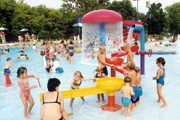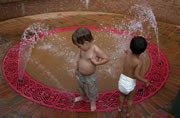Water Play Areas & Interactive Fountains
Keeping Water Play Areas / Interactive Fountains Clean

A more recent addition to the recreational water attraction scene is the water play area (may also be called an interactive fountain, wet deck, splash pad, spray pad, or spray park). People may not realize that although there is no standing water in these attractions, the spray water will rinse any contaminants (for example, diarrhea, vomit, and dirt) down into the water holding area and be sprayed again. In other words, the water is recycled through the system. As a result, it is possible for the water to become contaminated and cause outbreaks of illness.
Because water play areas / interactive fountains are relatively new, health departments may not have specific requirements for how this water is treated. It pays to be proactive by building water play areas or interactive fountains like any other water attraction is built. They should include adequate disinfection and filtration systems even if this is not currently required by the local or state pool code. The addition of secondary disinfection, like ultraviolet light or ozone, should be considered and is now required in New York State. Health departments should also ensure that pool codes are updated to include water features that do not have standing water.
Outbreaks Associated with Water Play Areas / Interactive Fountains

During the summer of 2005, an outbreak of cryptosporidiosis occurred at Seneca Lake State Park in New York. Over 1,700 people may have been infected with 425 laboratory-confirmed cases of cryptosporidiosis and 1,374 probable cases were identified (1). Cryptosporidium was traced to the water tanks that supplied the 11,000 square foot wet deck (spraypark). In response, New York passed emergency public health regulations to govern the design and sanitation of such attractions statewide.
A 1999 outbreak of diarrheal illness affected 44% of patrons (an estimated 4,800 people) who visited a new interactive fountain in a beachside park (2). When officials from the health department inspected the interactive fountain, they found that the water drained from the play area into an underground reservoir for recirculation. The problem turned out to be a result of inadequate chlorination and the lack of a filtration system. The chlorine tablet erosion feeder had not been filled for weeks and the designers did not include a filtration system.
- Shaffzin JK, Keithly J, Johnson D, Sackett D, Hoefer D, Hoyt L, Lurie M, Teal A, Rosen B, Tavakoli N, St. George K, Braun-Howland E, Wallace B . Large Outbreak of Cryptosporidiosis Associated with a Recreational Water Spraypark—New York 2005. 55th Annual Epidemic Intelligence Service Conference, 2006.
- Outbreak of Gastroenteritis Associated With an Interactive Water Fountain at a Beachside Park —Florida, 1999. MMWR, June 30, 2000 / 49(25); 565-8. Available at www.cdc.gov/mmwr/preview/mmwrhtml/mm4925a3.htm.
Get email updates
To receive email updates about this page, enter your email address:
Contact Us:
- Centers for Disease Control and Prevention
1600 Clifton Rd
Atlanta, GA 30333 - 800-CDC-INFO
(800-232-4636)
TTY: (888) 232-6348 - New Hours of Operation
8am-8pm ET/Monday-Friday
Closed Holidays - cdcinfo@cdc.gov
- For more information, please contact us at healthyswimming@
cdc.gov


